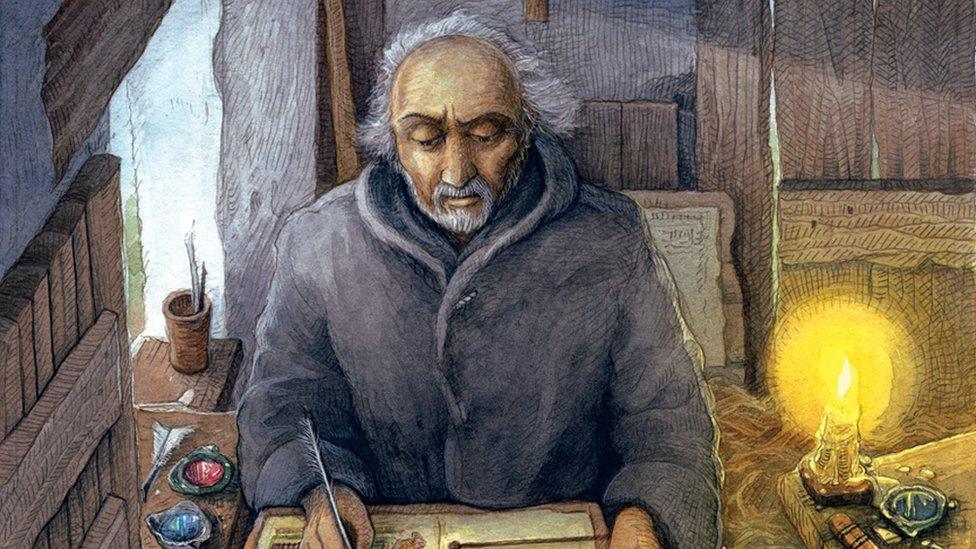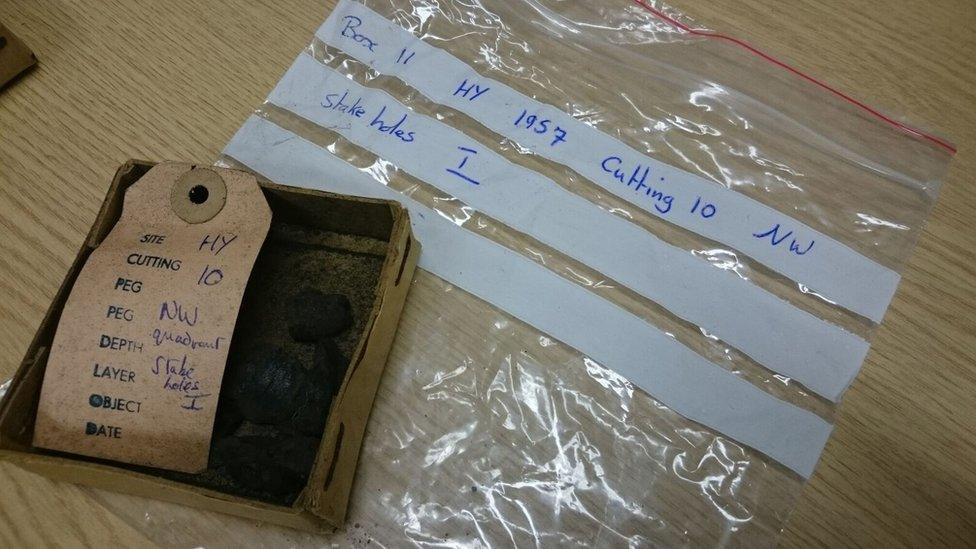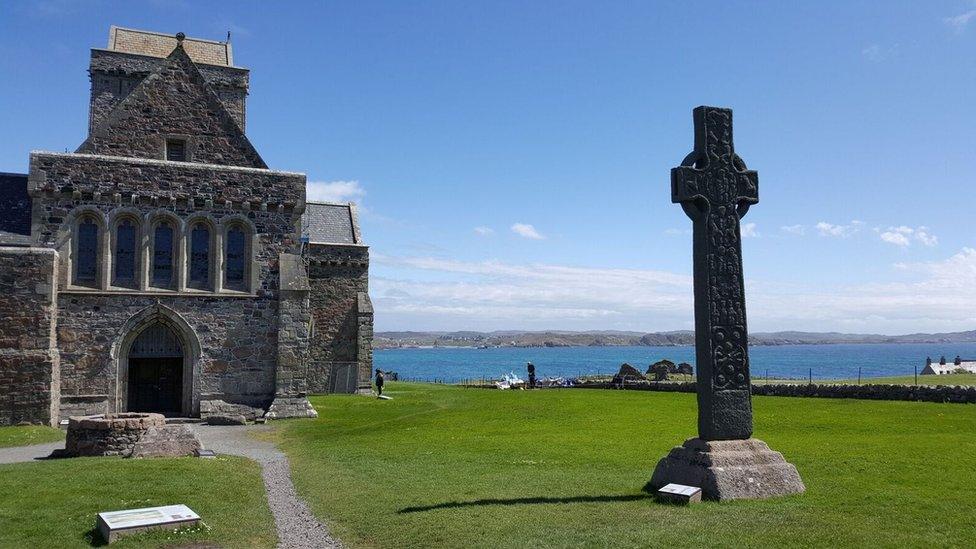Scientists uncover St Columba's cell on Iona
- Published

Accounts written about 100 years after Columba's death describe him sitting writing in a wooden hut on Iona
Archaeologists say they have identified the remains of the cell of St Columba on the Scottish island of Iona.
They have used radiocarbon dating to place samples of burned wood in the middle of Columba's time there almost 1,500 years ago.
The charred remains of a hut were excavated in 1957, but it has taken until now for science to accurately date them.
The cell, or scriptorium, is where he worked, prayed and spent his last day.
The samples had been carefully stored at several universities - and latterly in a garage in Truro.
Centre of worship
St Columba arrived on Iona from Ireland in the year 563. His Gaelic name is Colum Cille - "the dove of the Church".
He is widely credited as one of the key figures who brought Christianity to Scotland.
From his vision sprang Iona Abbey, which became a centre of literacy, learning and worship.

Scientists used hazel charcoal to carbon date the hut
After his death Iona became a place of pilgrimage for kings and commoners. 60,000 of the latter still visit the rebuilt abbey every year.
But did Columba leave any physical trace?
His successor Adomnán, writing 100 years after the saint's death, described him working in his cell on a rocky hillock.
That knoll is called Tòrr an Aba - "the mound of the abbot".
Sixty years ago the site was excavated by a team led by the Cornish historian and archaeologist Charles Thomas.
It was early in a career in which he became the leading archaeologist of early Christianity in Britain and Ireland, with posts at Edinburgh and Leicester universities.
He eventually became the first professor of Cornish studies at Exeter University and a Bard of the Cornish Gorseth.

Charles Thomas stored the excavations from his digs on Islay in his garage
His dig in 1957 made an intriguing discovery.
On Tòrr an Aba the diggers found hazel charcoal, apparently the remains of a wattle hut.
The site had been deliberately covered with beach pebbles and there was a hole where a post - possibly a cross - had been placed.
Were these the remains of Columba's cell? Charles Thomas thought so.
Radiocarbon dating
If only they could be accurately dated. But in 1957 that was impossible.
The technique of radiocarbon dating was in its infancy then. It measures the level of carbon 14, a radioactive isotope, to assess the age of a sample of organic material.
But 60 years ago the process was expensive, required the destruction of a relatively large sample, and the dates it produced had a wide margin of error.
So Charles Thomas did not write up his findings in an academic paper. Instead he carefully preserved the samples from the dig along with his notes.
He took the remains with him from university to university. After he retired he stored them in his garage in Truro.

Iona remains an important place of pilgrimage, with tens of thousands of people visiting its Abbey every year
Which is where they sat until five years ago when a project led by University of Glasgow archaeologists Dr Ewan Campbell and Dr Adrián Maldonado heard of them.
Prof Thomas was happy to hand them over for testing using radiocarbon techniques of an accuracy unimaginable six decades ago.
The project, funded by Historic Environment Scotland and supported by the National Trust for Scotland, had the samples tested by the Scottish Universities Environmental Research Centre.
The result? The remains of the hazel stakes date the hut between the years 540 and 650. Columba died in 597.
Adrián Maldonado says it is "within a standard deviation of the lifetime of St Columba", which he says is "about the closest you can get to being certain that it is something that was standing when Columba was on Iona".
Historic Environment Scotland's Senior Archaeologist Richard Strachan is similarly enthusiastic.
He said: "It's fantastic, it absolutely nails it. There's no debate. We can actually prove this scientifically. This is real. This actually happened here."
Historic Environment Scotland are funding the project as part of Scotland's Year of History, Heritage and Archaeology 2017.
As well as re-opening some of the 60-year-old trenches to look for more dating material, Doctors Campbell and Maldonado are writing up Charles Thomas's personal archive.
'Spiritual figure'
Some of the early findings are being unveiled at the 8th International Insular Art Conference at the University of Glasgow.
Dr Campbell says it is extremely rare to be able to associate any archaeological deposits with a figure from the past.
He said: "This being Columba, who is so important as a spiritual figure and as a person who founded this series of monasteries which cultivated that learning which spread throughout Europe, it's really important.
"It's really exciting to be able to touch some of the things that were associated with him."
Sixty years on, some of Prof Thomas's fellow diggers on Iona are still alive.
They were as sure as they could be that this was the saint's scriptorium, but lacked the backing of modern radiocarbon dating.
Sadly Charles Thomas did not live to see his work vindicated. He died last year before the definitive date of his samples could be established.
But Dr Maldonado is in no doubt about the significance of his legacy: "What Charles Thomas and his team found - and couldn't prove until now - was that we've been walking on the early monastery this whole time."